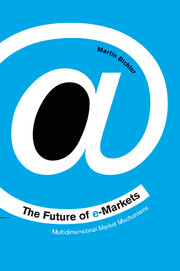Book contents
- Frontmatter
- Contents
- List of figures
- List of tables
- Preface
- Acknowledgments
- 1 Electronic Commerce and Electronic Marketplaces
- 2 Internet Marketplaces – A Technical Perspective
- 3 The Diffculty of Setting Prices
- 4 Methods for the Analyses and Design of Electronic Markets
- 5 Automated Negotiations – A Survey of State-of-the-Art Practices
- 6 Experimental Analysis of Multi-Attribute Auctions
- 7 Economic Models of Multi-Attribute Auctions
- 8 Conclusions and Perspectives
- Appendix: Utility Theory and Decision Analysis Techniques
- References
- Index
8 - Conclusions and Perspectives
Published online by Cambridge University Press: 22 September 2009
- Frontmatter
- Contents
- List of figures
- List of tables
- Preface
- Acknowledgments
- 1 Electronic Commerce and Electronic Marketplaces
- 2 Internet Marketplaces – A Technical Perspective
- 3 The Diffculty of Setting Prices
- 4 Methods for the Analyses and Design of Electronic Markets
- 5 Automated Negotiations – A Survey of State-of-the-Art Practices
- 6 Experimental Analysis of Multi-Attribute Auctions
- 7 Economic Models of Multi-Attribute Auctions
- 8 Conclusions and Perspectives
- Appendix: Utility Theory and Decision Analysis Techniques
- References
- Index
Summary
Given that we are doing the equivalent of evolving monkeys that can type Hamlet, we think the monkeys have reached the stage where they recognize they should not eat the typewriter.
(Comment by Dallaway and Harvey, accompanying their 1990 entry into the Santa Fe Double Auction Programming Contest, Friedman and Rust, 1993)Following Shapiro and Varian (1999), I contend that the Internet does not so much change the fundamental characteristics of the general negotiation process, as the economic principles behind negotiations are still valid. Yet it does enable trading mechanisms to be implemented that were previously unknown or infeasible. This book has analyzed a broad range of negotiation protocols for electronic markets while focusing largely on auction mechanisms.
Auctions have proven to be very effcient negotiation protocols that converge to an equilibrium very quickly, which is important in situations where transactions need to occur at a rapid rate. Considering political contexts, auctions are also widely perceived as fair. In fact, they reflect the general shift of power towards the consumer, as sellers who do not offer some form of negotiation might be in danger of falling behind or being considered consumer-unfriendly. Aside from theoretical arguments, auctions have a number of practical advantages for both seller and buyer:
An auction mechanism releases the bid taker from having to negotiate with several bidders individually, thus saving time.
- Type
- Chapter
- Information
- The Future of e-MarketsMultidimensional Market Mechanisms, pp. 201 - 205Publisher: Cambridge University PressPrint publication year: 2001

